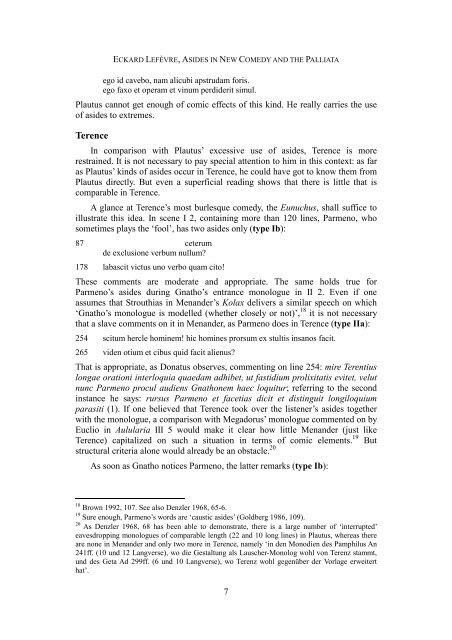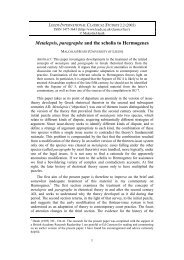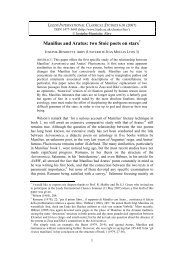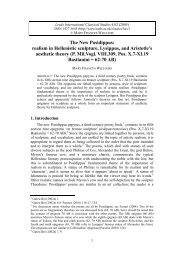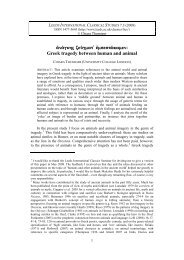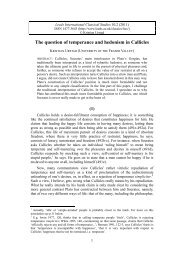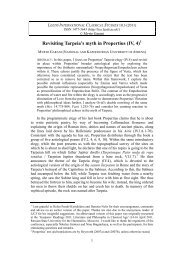Asides in New Comedy and the Palliata - Leeds International ...
Asides in New Comedy and the Palliata - Leeds International ...
Asides in New Comedy and the Palliata - Leeds International ...
Create successful ePaper yourself
Turn your PDF publications into a flip-book with our unique Google optimized e-Paper software.
ECKARD LEFÈVRE, ASIDES IN NEW COMEDY AND THE PALLIATA<br />
ego id cavebo, nam alicubi apstrudam foris.<br />
ego faxo et operam et v<strong>in</strong>um perdiderit simul.<br />
Plautus cannot get enough of comic effects of this k<strong>in</strong>d. He really carries <strong>the</strong> use<br />
of asides to extremes.<br />
Terence<br />
In comparison with Plautus’ excessive use of asides, Terence is more<br />
restra<strong>in</strong>ed. It is not necessary to pay special attention to him <strong>in</strong> this context: as far<br />
as Plautus’ k<strong>in</strong>ds of asides occur <strong>in</strong> Terence, he could have got to know <strong>the</strong>m from<br />
Plautus directly. But even a superficial read<strong>in</strong>g shows that <strong>the</strong>re is little that is<br />
comparable <strong>in</strong> Terence.<br />
A glance at Terence’s most burlesque comedy, <strong>the</strong> Eunuchus, shall suffice to<br />
illustrate this idea. In scene I 2, conta<strong>in</strong><strong>in</strong>g more than 120 l<strong>in</strong>es, Parmeno, who<br />
sometimes plays <strong>the</strong> ‘fool’, has two asides only (type Ib):<br />
87 ceterum<br />
de exclusione verbum nullum?<br />
178 labascit victus uno verbo quam cito!<br />
These comments are moderate <strong>and</strong> appropriate. The same holds true for<br />
Parmeno’s asides dur<strong>in</strong>g Gnatho’s entrance monologue <strong>in</strong> II 2. Even if one<br />
assumes that Strouthias <strong>in</strong> Men<strong>and</strong>er’s Kolax delivers a similar speech on which<br />
‘Gnatho’s monologue is modelled (whe<strong>the</strong>r closely or not)’, 18 it is not necessary<br />
that a slave comments on it <strong>in</strong> Men<strong>and</strong>er, as Parmeno does <strong>in</strong> Terence (type IIa):<br />
254 scitum hercle hom<strong>in</strong>em! hic hom<strong>in</strong>es prorsum ex stultis <strong>in</strong>sanos facit.<br />
265 viden otium et cibus quid facit alienus?<br />
That is appropriate, as Donatus observes, comment<strong>in</strong>g on l<strong>in</strong>e 254: mire Terentius<br />
longae orationi <strong>in</strong>terloquia quaedam adhibet, ut fastidium prolixitatis evitet, velut<br />
nunc Parmeno procul audiens Gnathonem haec loquitur; referr<strong>in</strong>g to <strong>the</strong> second<br />
<strong>in</strong>stance he says: rursus Parmeno et facetias dicit et dist<strong>in</strong>guit longiloquium<br />
parasiti (1). If one believed that Terence took over <strong>the</strong> listener’s asides toge<strong>the</strong>r<br />
with <strong>the</strong> monologue, a comparison with Megadorus’ monologue commented on by<br />
Euclio <strong>in</strong> Aulularia III 5 would make it clear how little Men<strong>and</strong>er (just like<br />
Terence) capitalized on such a situation <strong>in</strong> terms of comic elements. 19 But<br />
structural criteria alone would already be an obstacle. 20<br />
As soon as Gnatho notices Parmeno, <strong>the</strong> latter remarks (type Ib):<br />
18 Brown 1992, 107. See also Denzler 1968, 65-6.<br />
19 Sure enough, Parmeno’s words are ‘caustic asides’ (Goldberg 1986, 109).<br />
20 As Denzler 1968, 68 has been able to demonstrate, <strong>the</strong>re is a large number of ‘<strong>in</strong>terrupted’<br />
eavesdropp<strong>in</strong>g monologues of comparable length (22 <strong>and</strong> 10 long l<strong>in</strong>es) <strong>in</strong> Plautus, whereas <strong>the</strong>re<br />
are none <strong>in</strong> Men<strong>and</strong>er <strong>and</strong> only two more <strong>in</strong> Terence, namely ‘<strong>in</strong> den Monodien des Pamphilus An<br />
241ff. (10 und 12 Langverse), wo die Gestaltung als Lauscher-Monolog wohl von Terenz stammt,<br />
und des Geta Ad 299ff. (6 und 10 Langverse), wo Terenz wohl gegenüber der Vorlage erweitert<br />
hat’.<br />
7


